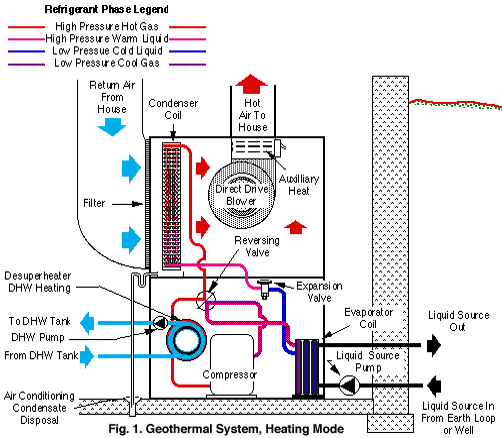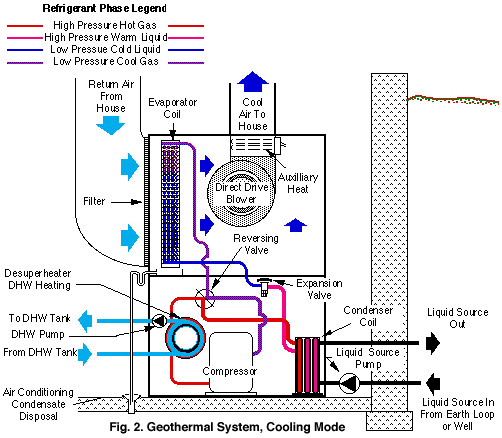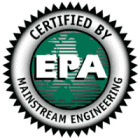- DIY
-
Articles
Planning for a Nuclear Detonation .pdf DOWNLOAD HVAC-Calc Residential Manual J Software DOWNLOAD NATURAL REFRIGERANT CO2.PDF DOWNLOAD U.S. Solar Heating Electric Duct Comparison.PDF DOWNLOAD Energy Cost Calc.xlr DOWNLOAD R S Means Mechanical Cost Data.mht DOWNLOAD Leaky Ducts.docx DOWNLOAD Residential Duct Systems.pdf DOWNLOAD Case Study.pdf DOWNLOAD
- Filters
- FAQS
- Case Study
- Links
- Manufacturers
- Ask John
Geothermal Heating & Cooling
If you have a water well that produces a sufficient amount of water, the initial cost can be minimized by using a open loop system. If you do not have a sufficient well, then the cost is higher as you need to drill wells deep enough or excavate horizontal loops to use the earth's temperature. Geothermal uses electricity to power the loop circulation pumps or the well pump and the heat pump compressor. Otherwise, geothermal heating is much more efficient than air source or other electric heat.
Geothermal heating and cooling requires no burning of fossil fuels at the heating or cooling locations, unlike other types of heating that use natural gas or heating oil furnaces. But in order to achieve the most comfort, geothermal heat pumps can be paired with a other heating systems to dramatically reduce the amount of fuel needed to heat the structure.
Why settle for 90% when you can have 500% - 600%
With geothermal cooling the heat is transferred from the building into the ground. Traditional ac transfers heat to the outside air which is hotter than the temperature you are trying to achieve indoors. Since the ground temperature at a depth of 6 ft (3 m) is about 53 degree (13 C) and since the ground transfers more efficiently than air, geothermal air conditioning is much more efficient. Also a large amount of excess heat is generated and can be used to heat your hot water, this also takes a little of the excess heat from the compressor.
This is a geothermal heatpump in heating

1. The Evaporator Coil is a tube filled with
water (Water Source Coil) and sealed inside of another larger tube
filled with refrigerant Gas (Tube-In-A-Tube Heat Exchanger or a coaxial).
2. As the cold refrigerant Gas flows through the outside tube of the
Evaporator Coil the water flowing through the inside tube of the Evaporator Coil
warms the refrigerant Gas. (Purple) The heat pump cycle begins as cold liquid
refrigerant passes through a heat exchanger and absorbs heat from the water
circulating through the loop.
3. The Compressor then compresses the refrigerant Gas (The Gas that
absorbed heat from the water circulating through the loop),
causing it to become very hot and under high-pressure, raising its temperature to
more than 160 degrees and pushes it into the Reversing Valve. (Red)
4. If the system thermostat is set to heating, then the Reversing Valve
moves the hot high-pressure refrigerant Gas into the coil. (Red)
5. As the hot high-pressure refrigerant Gas moves through the Condenser Coil,
the Fan blows air over the coil, heating the Conditioned Air Space and cooling
the refrigerant Gas. The heat is removed from the refrigerant gas and transferred to air, which is
then circulated into your house. (The temperature of the heated air or water is
about 100 degrees.) The refrigerant gas cools and condenses into its liquid form as it moves
through the Condenser Coil. (Pink)
6. When the cooled refrigerant Liquid moves through the Expansion Valve, the
liquid evaporates back into its gaseous form in the Evaporator Coil and gets very
cold in the evaporation process. (Blue)
Then the process starts over again.
This is a geothermal heatpump in cooling.

1. The Fan blows air over the Evaporator
Coil, cooling the Conditioned Air Space and warming the refrigerant Gas. (Purple)
Moving warm air out of your house and through the Evaporator Coil absorbing the
heat into the refrigerant Gas.
2. The Compressor compresses the refrigerant Gas (The Gas that absorbed
heat from the warm air circulating through house), causing it to become very hot
and under high-pressure, and moves it into the Reversing Valve. (Red)
3. If the system thermostat is set to cooling, then the Reversing Valve
moves the hot high-pressure refrigerant Gas into the Condenser Coil (Tube-In-A-Tube Heat Exchanger). (Red)
4. As the hot Gas flows through the outside tube of the
Condenser Coil the water flowing through the inside tube of the Condenser Coil,
heating the water and cooling the refrigerant Gas., and the gas condenses into its
liquid form as it cools. (Pink)
5. When the cooled refrigerant Liquid goes through the Expansion Valve, the
liquid evaporates back into its gaseous form in the Evaporator Coil and gets very
in the evaporation process. (Blue)
Then the process starts over again.
Most geothermal systems
have a Hot Water Generator(HWG's) that take refrigerant from
the compressor, where it is very hot, and directs it to another small coaxial
heat exchanger. In this HWG heat exchanger, water from a domestic hot
water tank flows through, picking up heat from the hot refrigerant. This heat
exchanger is double-walled, and vented so that there would be no contamination
from the refrigerant if a leak occurred.
The HWG accomplishes three functions.
First, it typically heats 60% to 80% of a home's hot water for FREE
utilizing waste heat from the refrigeration process.
Second, it increases the efficiency of the compressor by removing some of
the heat from the compressor.
Third, it increases the life expectancy of the compressor by allowing it
to operate at a cooler temperature.
Geothermal heating and cooling takes advantage of the natural stable warmth stored in the earth. Normally the earth temperature is around 55 degrees F (13 degrees C) at depths of 10 ft. In climates warmer than 55 degrees F (13 degrees C), this can be used to air condition a building, and in colder climates (those under 55 degrees F or (13 degrees C) it can be used for heating. This is accomplished by one of a number of methods. A geothermal heat pump uses the extracted water or transfer fluid (such as water mixed with antifreeze) as a heat source in winter and a heat sink in summer. Some geothermal heat pumps provide heating and cooling via forced air distribution, and others through the heating and/or chilling of water for radiant type systems. Some systems are used for heating domestic hot water.
Geothermal heating and cooling systems use the natural constant ambient temperature of the earth to heat in the winter and cool in the summer. This is accomplished with a compressor or heat pump unit, the liquid heat exchanger medium, and the air delivery system.
Quite simply, geothermal systems in heating take heat from the earth, transfer that heat to a refrigerant, then distribute the heat into the structure with a forced-air or hydronic system.
In air conditioning, geothermal systems take heat from the structure, transfer the heat to the refrigerant, then transfer the heat back to the water or loop fluid. This works the same as a standard air conditioner, except a geothermal system uses water or loop fluid at a constant temperature (average 50 degrees) instead of varying outdoor temperature.
In other words, it's like heating and cooling your home when it's 50 degrees outside all year!
Since water from the Earth is a constant
temperature (approximately 55 degrees F in the Northeast), the geothermal heat
pump has a constant source of 55 degrees F energy with a open loop system.
With a closed loop system the fluid circulates continuously
inside the buried pipe, absorbing heat from the earth during the winter for use
inside your home or business. In warmer months, the fluid takes heat from indoors
and transfers it back into the earth.
An increasingly popular approach, especially in residential
geothermal systems, is a "slinky" coil. A slinky is a coil of plastic tubing
spread out and overlapped in a trench and buried. Slinky coils are installed
horizontally at the bottom of a three-foot-wide trench. (Depth my vary by
location, but at least 5 ft.) This method concentrates the heat transfer surface
into small volume, requiring less land area and shorter trenching - a big plus
for homeowners.
The geothermal heat pump is not subject to freezing like an
AAHP unit, and operates without any problem regardless of outside
temperatures.
The geothermal heat pump is extremely efficient; up to 400%
more efficient than conventional heating systems according to the US Department
of Energy.
Types of
geothermal heating and cooling systems:
Closed Loop.
Loops of pipe are buried in deep, vertically-drilled holes, often 200 ft (60 m) and greater
below ground level and grouted or pipes are placed horizontally (buried in trenches) at a depth of 6 ft (2 m) and greater in the
ground.
Water and antifreeze (or other transfer fluid) are circulated through the heat
exchanger (heat pump) and back out through the loops continuously. Some closed
loop systems bypass a portion of their working fluid with a thermostat to keep
the source temperature stable.
Open Loop.
Pipes draw water from a nearby water well, shallow body of water or a spring.
Once this water passes through the heat pump, it is released back to its source,
generally as far from the intake as possible.
Loop Parts loop pit field done
H W G unit hookup H W G hot tank 1 H W G hot tank 2 H W G top of hot water tank H W G bottom of water tank

Geothermal Heat Pumps
Heating & Cooling
Floor Heating Systems
- Are you looking for floor heating systems to make your room cold free forever? Then you have chosen the right path. At Heavenly Heat Inc., you can find the different types of comfortable and effective floor warming systems at reliable price.
Saving Energy with Insulation
Electric
Heat Pump Guide
Cleaning Fibrous Glass
D I Y ductwork
Download eDrawings
NAIMA
Heat Pumps
How much electricity does my stuff use
green building talk.com - Forums
air distribution system installation pdf
YouTube - My Geothermal Waterfurnace - Strategies 4 Survival
Pennsylvania Association of Building Code Officials, Inc.
FirstEnergy Corp.
American Society of Heating, Refrigerating and Air-Conditioning Engineers
Department of Energy Assistant Secretary Energy Efficiency and Renewable Energy
EERE Consumer's Guide Geothermal Heat Pumps
Geothermal Heat Pump Consortium, Inc.
IGSHPA - Down to Earth Energy
Registration for GeoExchange (ground source heat pump) IGSHPA Certification Schools
The Source for Renewable Energy
Heatpump Links Directory - Main - Heat Pump
Solar Information
Solarpowernotes.com
solar panel articles-solar panels, solar energy, solar power, and more
Heating and Cooling
The Slim Jim Geo Lake Plate
Geothermal Heating
Concrete Homes Insulating Concrete Forms Portland Cement Association
Insulating Concrete Forms (ICF)
Quad-Lock Insulated Concrete Forms = Better Buildings
 Addison Products
Addison Products
 Bard Manufacturing
Bard Manufacturing 
 Bosch
Bosch 
 Climate Master
Climate Master
 Commandaire
Commandaire
 ECONAR
ECONAR
 ECR Technologies
ECR Technologies
 FHP Manufacturing
FHP Manufacturing
 GeoComfort
GeoComfort
 HydroHeat, LLC
HydroHeat, LLC
 Hydron Module
Hydron Module
 Hydro-Temp
Hydro-Temp
 Mammoth,
Inc.
Mammoth,
Inc.
 McQuay
McQuay
 WaterFurnace
WaterFurnace
 Flow Center
Products
Flow Center
Products
 Thermcosupply.com
Thermcosupply.com
 Geothermal Supply
Co.
Geothermal Supply
Co.
 Integrity Fusion
Integrity Fusion
 AEPCOR-Geothermal
AEPCOR-Geothermal
 Morris
Industries
Morris
Industries
 BlueRidgeCompany
BlueRidgeCompany
 Geo-Hydro Supply, LLC
Geo-Hydro Supply, LLC
Note: I do not recommend or endorse a specific dealer or product, and we do not certify work performed.
 IGSHPA
IGSHPA
 Dept. of Energy
Dept. of Energy
 ENERGY STAR
ENERGY STAR
geothermal system
was a
1912 Swiss patent.
heating and cooling
saves more than
14 million barrels
of crude oil per year.
Please donate to keep this site active.
Geothermal Heating and Cooling Information with annotated diagrams.
Current geothermal heating and cooling saves more than 14 million barrels of crude oil per year.


